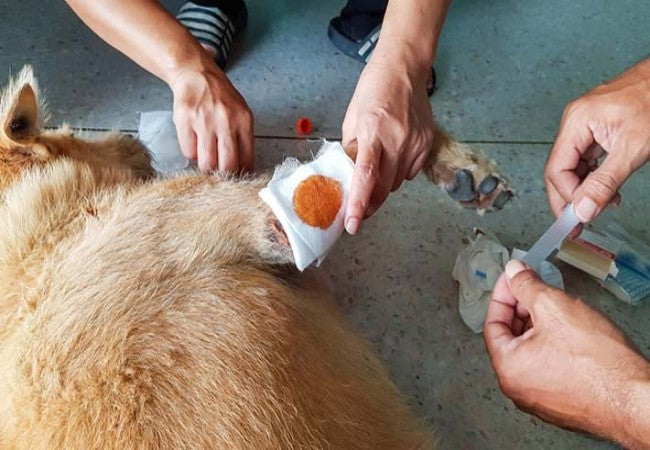How to Safely Clean Your Dog’s Wound at Home: A Vet-Approved Guide for 2025 🩺🐶

In this article
How to Safely Clean Your Dog’s Wound at Home: A Vet-Approved Guide for 2025 🩺🐶
By Dr. Duncan Houston BVSc
Whether it's a minor scrape from romping outside or a small cut from a rough surface, knowing how to clean your dog's wound at home can help prevent infection and support healing. 🩺 But it's important to do it safely—with the right tools and knowledge. Here's your complete 2025 guide, approved by veterinary experts. 🧠
🧼 What You Can Safely Use to Clean a Dog’s Wound
When treating a superficial wound at home, always begin with clean hands and a calm environment. Use the following options for wound cleaning:
✅ 1. Saline Solution (Best First Step)
- Why: Non-irritating, gentle, and safe for most wounds.
- How to Make: Mix 1 teaspoon of table salt in 2 cups of cooled, boiled water.
- How to Use: Use a clean syringe, gauze, or soft cloth to gently flush or dab the wound. Repeat if debris is visible.
✅ 2. Diluted Chlorhexidine Solution (0.05%)
- Why: Broad-spectrum antiseptic commonly used in veterinary clinics.
- How to Use: Only use if properly diluted to 0.05%. You can find pre-diluted veterinary solutions or ask your vet how to prepare it at home.
- Note: Avoid contact with eyes or deep puncture wounds.
✅ 3. Diluted Povidone-Iodine (Betadine)
- Why: Effective antiseptic that fights bacteria, fungi, and viruses.
- How to Use: Dilute with water until it resembles weak tea. Apply gently with gauze or a cotton ball.
❌ What NOT to Use on Your Dog’s Wound
Some household products are harmful or too harsh for pets. Avoid the following:
- Hydrogen peroxide: Damages healthy tissue and delays healing.
- Rubbing alcohol: Painful and irritating, especially on open wounds.
- Essential oils: Many (like tea tree or eucalyptus oil) are toxic to dogs.
- Human antibiotic ointments: Can cause allergic reactions or be licked and ingested.
🩺 When to See a Veterinarian
While minor scrapes may be treated at home, professional care is necessary in these cases:
- The wound is deep, large, or bleeding heavily.
- There’s swelling, pus, or a foul odor.
- Your dog is excessively licking or chewing the area.
- The wound is near joints, eyes, genitals, or paw pads.
- Your dog seems lethargic, in pain, or has a fever.
💡 Additional Wound-Care Tips
- Keep your dog from licking or biting the wound. Use a recovery cone or dog-safe bandage wrap if needed.
- Monitor for signs of infection: redness, heat, swelling, or discharge.
- Clean once or twice daily, depending on your vet’s advice.
📱 Enhance Your Dog’s Care Routine with Trusted Resources
For real-time guidance or follow-up questions, consider these helpful tools:
- Ask A Vet — Get immediate support from licensed veterinarians. 🩺
Download the Ask A Vet app to ensure your pet’s recovery is safe, supported, and expertly guided in 2025 and beyond. 📲🐾






